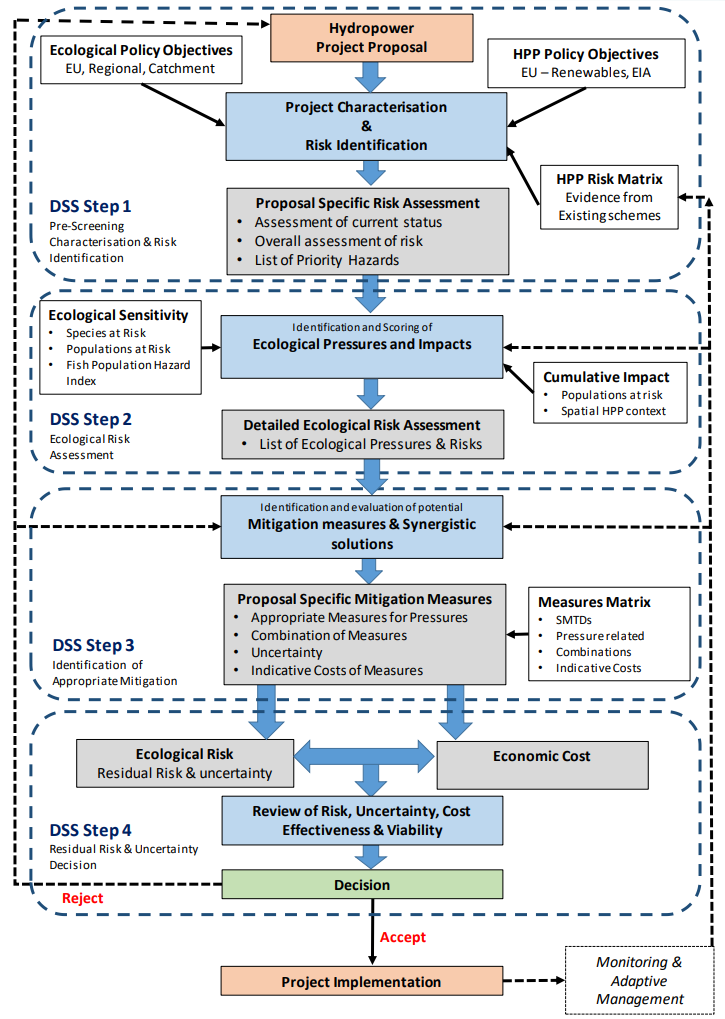Decision support system
The proliferation of hydropower development to meet obligations under the Renewable Ener-gy Directive has also seen the emergence of a conflict between the hydropower developers and the fisheries and conservation sectors. The hydropower industry wants a joined up re-sponse to their planned developments with sound guidance and timely decision-making. On the other hand, the fisheries and conservation interests have concerns over the impact that these schemes can have (especially the impact on WFD and Habitats Directive status) and want to be fully consulted on proposed schemes. They need to be reassured that the stand-ards of design, construction and operation will provide adequate protection of wildlife and biodiversity, and the ecosystem services that they provide. As a result, there is a need to de-velop robust and transparent, evidence-based, support for decision making that is easy for developers and regulators to use while enabling a high level of appropriate environmental protection and mitigation.
Whilst many guidelines exist for assessing the sustainability of hydropower schemes or the need for retro-fittingretrofitting existing structures, they are often limited in their assessment of risks and uncertainty about the impact of schemes on fisheries and the environment. Few provide support for the decision-making process at each stage of evaluation. At each stage of the process, decisions have to be made about the acceptability of the risks and uncertainty of impacts of hydropower schemes, and the ability to manage those risks. A comprehensive protocol, based on a risk assessment framework, developed in the FIThydro project to ad-dress this issue is described in this report.
Here, we have developed a planning and decision framework comprising a sequence of four key steps, each encompassing a series of key considerations and decisions. The framework enables operators and regulators to develop structured proposals for new HPP schemes, and to both, review and risk assess, those proposals whilst identifying appropriate mitigation measures to address the impact of both new and existing HPP schemes. The framework leads the decision maker through four key steps which act to characterise, risk-assess (and prioritise) the scheme(s) together with the identification of the most appropriate and potential-ly cost-effective mitigation options addressing the hazards and impacts arising due to the na-ture and context of the specific scheme(s).
The final FIThydro decision-support tool is based on the project management approach and outlines the steps that should be undertaken for the initial screening of a project to appraise the impacts, risks and scope options for further diagnosis and mitigation. Question catalogues, risk assessments and filtering tools are produced which cover aspects of ‘initial screening’, ‘ecological impacts’, ‘environmental status’, ‘mitigation measures’, and ‘risk and uncertainty’. Taken together, these aid the production of a project screening/scoping report designed to provide a systematic approach to decision-making for proposals relating to hydropower schemes and their mitigation. The Decision Support System (DSS), is presented in the form of an open access web-based tool which utilises and showcases some of the tools and out-puts produced by the FIThydro project and which will act as a structured gateway to the wid-er project results.
The FIThydro DSS web tool (https://www.dss.fithydro.wb.bgu.tum.de/) is aimed at regulators, engineering consultants, developers and operators and orientated around a single, risk-based, planning structure. The implementation of the planning/decision framework within the DSS is focused around a risk-based 2D matrix between the classes of hazards (impact) of a hydropower plant’s operation and location (upstream habitat, downstream flows, upstream migration, downstream migration and turbine mortality, and sediment transport) and the spe-cies identified to be at risk. This matrix reports a summary assessment of the risks posed by a scheme and as a gateway into prioritising hazards for mitigation in relation to ecological status and objectives and then selecting appropriate hazard specific mitigation measures (filtered from a catalogue of potential measures).
